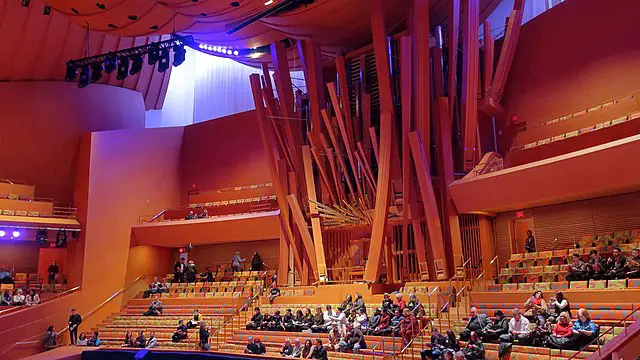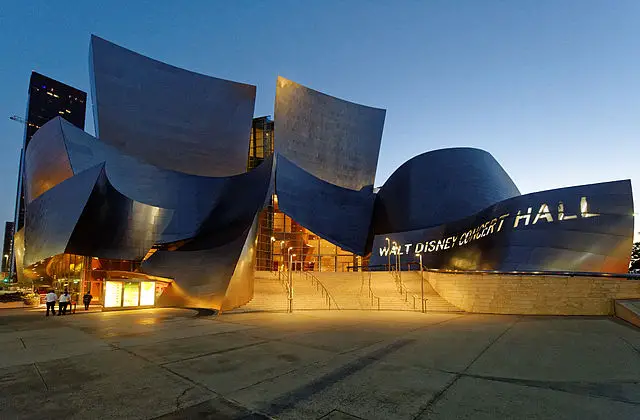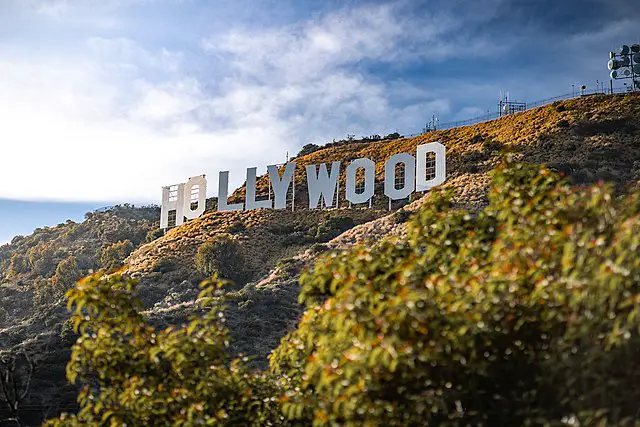
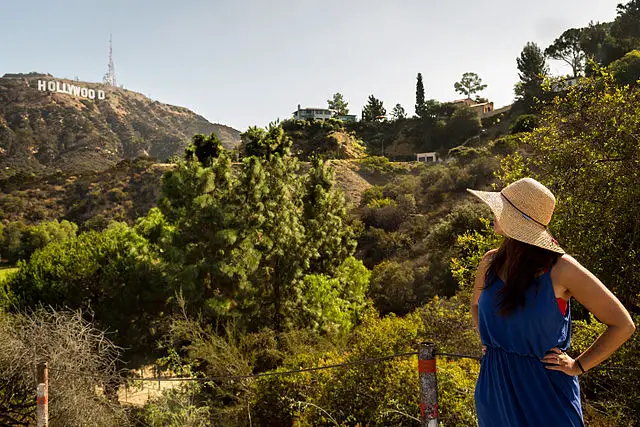

The Hollywood Sign, previously known as the Hollywoodland Sign, is a famous landmark and symbol of Hollywood. It is located on Mount Lee in the Santa Monica Mountains’ Beachwood Canyon region. It was originally built in 1923 as a temporary sign for a nearby real estate development, spelling out Hollywood in 45-foot (13.7 m) tall, white capital letters along a 350-foot (106.7 m) length. However, due to growing recognition, the sign was left up and replaced in 1978 with a more robust all-steel construction. The sign, one of California’s and America’s most well-known monuments, is frequently depicted in popular culture, especially in setting shots for motion pictures and television shows set in or near Hollywood. Similar-looking signs with varying word spellings are frequently interpreted as parody. The Hollywood Chamber of Commerce is the owner of the trademark for the Hollywood Sign, but only for specific applications. The sign has frequently been the victim of pranks and vandalism over the years because of its vast recognizability and its visibility from numerous locations in the Los Angeles Basin. Since then, rehabilitation efforts have been made, including the installation of a security system to prevent mischief. The Hollywood Sign Trust, a nonprofit organisation, protects and promotes the sign, and Griffith Park owns the area where it is located. From Griffith Observatory or the Bronson Canyon entry to Griffith Park, visitors can hike to the sign. Outside of Griffith Park, there is a trailhead at the Lake Hollywood Reservoir. Although it is not an access point in and of itself, the trailhead is close to a well-known picturesque view point. Canyon Lake Drive, which is close to the Hollywood Reservoir, is the site that is easiest to reach by car. In order to keep neighbours from getting annoyed, the route is not made public.
The sign may be viewed in a variety of other close-by places, like the Griffith Park Observatory, so you don’t have to go to a residential area to see it. Although it may be seen from several spots along Hollywood Boulevard’s Walk of Fame, it is simpler to see from the upper levels of the shopping centre surrounding the Kodak Theater. There are options for seeing the sign on scheduled tours.
Raging Waters is a 50-acre waterpark which opened in 1983, located in Los Angeles County in the city of San Dimas It has been recognized by USA Today as a “Top 10 Waterpark”. More than 50 classic rides, slides, and attractions that the whole family can enjoy, including California’s one and only hydromagnetic water coaster. For anyone wanting to stay cool and have a day of summer fun, Raging Waters is the place to be.
Attractions at Raging Waters include slides and water rides with twists, turns, and speeds up to 40 miles per hour, a lazy river for those wanting a little rest, bodyboarding, a water obstacle course, four different kiddie areas perfect for even the youngest visitors. The Aqua Rocket is a coaster-style slide that uses magnetic propulsion to propel a raft up hills. Amazon Adventure is a quarter-mile-long, 3-foot-deep (0.9 m), tropical river that runs through a section of the park. Riders sit in rafts as the current pulls them around the river route. Bermuda Triangle consists of three twisting, turning, downward tunnels that recycle more than 2,500 gallons of water a minute and make riders feel like they have entered the Bermuda Triangle. Bombs Away will open in 2023. It will be two trapdoor slides one with an open free fall drop and the other with an enclosed loop. Dark Hole is a system of two fiberglass tunnels with a total drop of fifty-two feet. Riders used to sit in a single-person raft identical to the ones used in Amazon River, but as of 2016 riders sit in a two-person raft speeding through the total darkness of the long flumes, the first of its kind in the country. Riders travel at a speed of 26 miles per hour. Dr. Von Dark’s Tunnel of Terror is a slide in which riders experience a 40-foot drop into a dark tunnel. Riders will then drop into a small mini-funnel. Dragon’s Den is a slide which debuted in 2004 and is a two-rider tube ride that sends guests plummeting down a steep 45-foot (14 m) tunnel, circling around a 35-foot (11 m) bowl 9-foot (2.7 m) until they fall through a secret tunnel at the bottom. As of 2016, Dragon’s Den is ridden as a single-rider with tubes identical to the ones used in Amazon River. DropOut is a seven-story body slide. Riders plunge at a near free fall, reaching speeds close to 40 miles per hour. Some riders will lift off the slide when coming down. As of 2021 season was closed and removed.
Private poolside cabanas are available for daily rental use. Different dining options are available in the park ranging from quick eats to fine dining. Raging Waters is open from mid-May through September. Hours and pricing vary depending on the day you plan your visit. This is a family-friendly place to enjoy some fun in the sun.


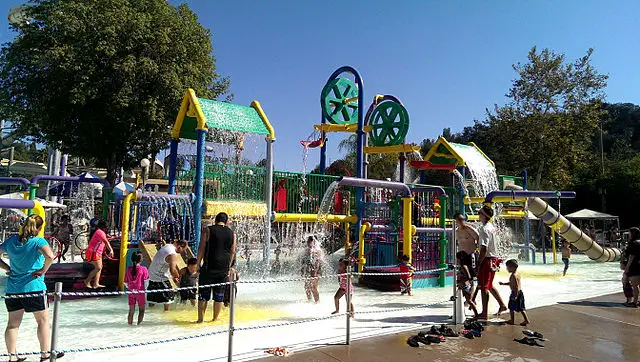
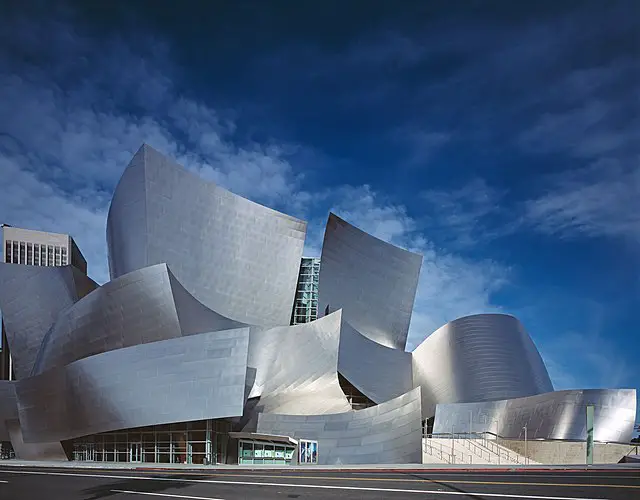

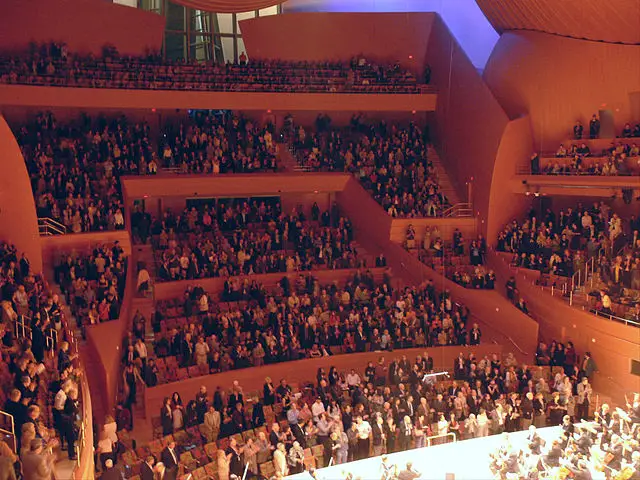
The Walt Disney Concert Hall, was created by Frank Gehry and is the fourth hall of the Los Angeles Music Center, located in the heart of Los Angeles. 2003 saw its debut. It has a capacity of 2,265 and is home to the Los Angeles Master Chorale and Los Angeles Philharmonic Orchestra, among other things. It is located in the Hope Street, Grand Avenue, and 1st and 2nd Streets neighbourhood. The structure of the hall is a compromise between a traditional shoebox layout like that of the Boston Symphony Hall or Vienna Musikverein and a seating arrangement resembling that of Hans Scharoun’s Berliner Philharmonie. As a present to the people of Los Angeles and a monument to Walt Disney’s love of the arts and the city, Lillian Disney made an initial pledge of $50 million in 1987 to construct a performance venue. Contrary to its predecessor, the Dorothy Chandler Pavilion, both the architecture and acoustics of the concert hall by Minoru Nagata, whose assistant and protégé Yasuhisa Toyota oversaw the final construction, have received accolades. This performance space can be enjoyed without spending money on concert tickets: The exterior and interior of the venue are both accessible via docent-led tours and self-guided audio tours (though the actual concert auditorium is off-limits). Free hour-long guided and audio tours are available Monday through Saturday from 10 a.m. to 2 p.m. or 2 to 5 p.m., while guided tours are typically offered on Thursdays, Fridays, Saturdays, and Sundays. The hours of the guided tours vary by day and are typically available on Thursday, Friday, Saturday, and Sunday.Near the 7th Street/Metro Center and Pershing Square Metro stations on the Red, Purple, Blue, or Expo lines, the Walt Disney Concert Hall is situated a few blocks to the north-east. Facilities like restrooms, beverage stands, and a gift shop are inside the hall and are open Tuesday through Sunday from noon to 6 p.m.
